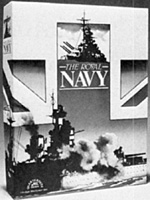 Designed by Jack Green
Designed by Jack Green
Quarterdeck Games
PO. Box 658, Cambria, CA 93428
Released: 1984
Price: $17.00
Complexity: Intermediate
Solitaire Suitability: Very High
The Royal Navy is a detailed naval game designed to provide the high level of realism found in naval miniatures while retaining the advantages of a boardgame. The game contains 180 ship counters that permit you to play twelve prepared scenarios or to make up your own for WWI or WWII with British, American, French, German, Italian, and Russian ships. There are also a number of other counters to indicate fires, torpedo hits, and smoke screens.
The game is played out on a hex sheet which allows maneuver and range mea- surements. The armor penetration chart relates guns, distance, and armor; a series of ship statistics tables provides game data, but not historical data.
The copy reviewed came with three ships' logs which have to be marked with a given scenario's ships statistics for each game. You should photocopy the log for future play because the copies provided won't last through three scenarios. The rules are clear, but even after a second reading, they require some interpretation of the designer's intentions. To fully understand them, you must play a practice scenario.
The data in the ship data sheets are a bit jumbled; however, this is a very minor problem. Another problem lies in the combined time chart/armor penetration table; this table has too much data on it to be clear. Lines overlap making it difficult to follow The designers should have broken up this table by nationality to minimize overlapping and provide each player with his own reference table. I recommend that the time chart be on something else because I found myself constantly picking up the table in an effort to decipher the spaghetti of penetration lines. I kept losing track of the turn.
The game has two alternative systems of player movement. one is a system of split turns and initiatives; the player with the worst initiative moves half his move first. Then the player with superior initiative moves his full move and the lower initiative moves the remaining half of his movement. As an option, simultaneous, secret, written movement is allowed and the rules for this are provided.
The number of gunfire hits is determined by die roll. Hits are then converted to damage via another die roll. Comparison of armor and shell size can be found on an armor penetration chart. Torpedo hits and damage are also determined by die rolls.
The scenarios are historical, but the victory conditions equalize the chances for victory and degrees of victory are provided. Victory depends on the player's skill of maneuvering and throwing dice.
Two different scenarios were played. The first, Graf Spee for the German player vs. Exeter, Ajax and Achilles, for the British player showed the balance of the game clearly. Average die rolling left the determination of the victor to the most skillful player.
The second scenario, Goeben and Breslau, for the German player vs. indomitable and Indefatigable, for the British player, showed that good dice rolling makes you a tough player. The first salvo from Goeben absolutely trashed the Indomitable, hitting her five times and punching through her paper-thin armor. The return volley from Indomitable showed the second weakness of the British battle cruisers. Even though she hit Goeben, her shells were unable to penetrate. The Indefatigable then received similar treatment-she was battered into a total wreck. The damage inflicted on Goeben was limited to two hull hits, one movement hit, and two secondary hits.
At $17.00, the game is well worth buying if you are into naval wargaming. It provides enough challenge to keep the best players interested in playing it time and again. I recommend it to those who want a game that provides a small scale, but detailed game.
LCDR CE Naftiger began wargaming in 1967 and is an ardent gamer, specializing in Napoleonic miniatures and board games He has authored The Bavarian and Westpbalian Armies 1799-1815, The Russian Army 1800-1815, and The British Military: Its System and Organization 1803-815).
More Reviews
-
Game Review: Panzer Command
Game Review: Southern Front (WWIII)
Game Review: Liddell Hart's Second World War
Game Review: Royal Navy
Game Review: Hitler's War
Game Review: Sixtomania
Game Review: Rush Hour
Game Review: Constellation
Game Review: Dr. Who
Game Review: Invasion US, Rogue 417
Game Review: Fringeworthy (sci-fi RPG)
Game Review: Super Squadron (Superhero RPG)
Back to Table of Contents -- Game News #3
To Game News List of Issues
To MagWeb Master Magazine List
© Copyright 2000 by Dana Lombardy.
This article appears in MagWeb (Magazine Web) on the Internet World Wide Web.
Other military history articles and gaming articles are available at http://www.magweb.com